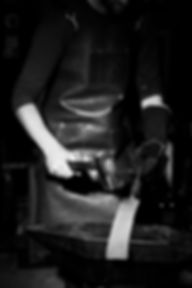What makes a sharp knife cut
- Aidan Mackinnon
- Sep 4, 2019
- 3 min read

Everyone knows that a sharp knife cuts more effectively than a dull one – but do you know why, exactly?
It all has to do with the physics of cutting.
We must begin at the beginning – what exactly is sharp? While the term is ubiquitous and certainly feels like it should be easy to define, unfortunately there is no agreed-upon definition.
Out of all the definitions, I feel the one that is most applicable relates to the force required to make a cut.
Cutting anything always starts with a crack. In the kitchen, we use a knife to open and expand a crack in the food we’re cutting—whether we’re gently slicing or aggressively chopping it.
The edge of a knife is a force multiplier. It takes whatever force is being applied to it and concentrates it onto the surface you are cutting. The knife is taking all of the force from you pushing your knife into food and applying it to a smaller amount of surface area - the cutting edge.
The same force divided by less surface area (such as a thinner, sharper knife) equals more force focused on a small area. If the force exerted by the blade’s edge is greater than the strength of the material you are cutting...the material is cut.
Sharp knives need less force to cut than dull knives. Less force means less damage to the food, which you can easily see by looking closely at the cut. Delicate ingredients, like herbs, will look fresher for longer if you slice through them cleanly, whereas a dull knife will crush more of the cells surrounding the cut, which ultimately accelerates wilting and discoloration.

But what about slicing versus chopping?
Chopping is all about pushing the blade of your knife downward. When your knife strikes the surface of the ingredient, there is a split second during which the food beneath the blade is compressed into a V-shaped valley. A moment later, a threshold is crossed, and the food ruptures under compressive force. Now the blade plunges downward, propagating this crack through the food. If the compressive force is not strong enough to break the intermolecular bonds of the material we are trying to cut, you will do nothing more than squash your food flat. Not pretty.
Slicing on the other hand applies compressive force as well as shear stress (the draw cut). The combining of these two forces increases the force at the local of the cut without creating greater deformation of the whole. Think about a tomato: a sharp knife will slice easily into the surface even if it can’t push cut the tomato without deforming the outside of it.

The key is to remember that a sharp knife is a safe knife.
A sharp blade is predictable. When it strikes or is drawn across the food’s surface, it won’t slip. This makes it easy to control how the blade moves through the food, giving you control over your chopping or slicing. A dull blade will slip, which makes control difficult and increases the risk that it will slip into your finger. With a dull knife, it’s only a matter of time until you badly cut yourself (I have learned from experience).
Fun Fact: The sharpest object ever made is a tungsten needle that tapers down to the thickness of a single atom. It was manufactured by placing a narrow tungsten wire in an atmosphere of nitrogen and exposing it to a strong electric field in a device called a field ion microscope.The nitrogen reacts with the tungsten more rapidly in places where the curvature was higher, eventually producing a tip of atomic radius. These tips (called nanotips) are used in scanning tunnelling microscopy (STM) to reveal the surface features of materials at atomic resolution. A little sharper than you need for chopping up your veggies – but it illustrates what true sharpness looks like on a molecular scale. For those who are interested in the physics of cutting, Professor Mahadevan, an applied physics researcher at Harvard University, has published a wonderful paper on this subject, and you can find it here. And there is an excellent article by Knife Steel Nerds on Cutting here
